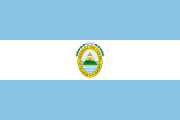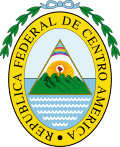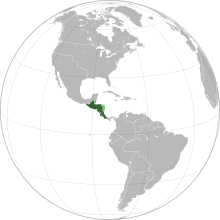Central American Confederation
| Confederación de Centroamerica | |||||
| Central American Confederation | |||||
| 1823-1841 | |||||
|
|||||
| Official language | Spanish | ||||
| Capital | Guatemala City (until 1834), San Salvador (from 1834) | ||||
| Form of government | Presidential Republic | ||||
| Head of state , also head of government |
José Cecilio Díaz del Valle (1823–1825) Manuel José Arce y Fagoaga (1825–1829) José Francisco Barrundia y Cepeda (1829–1830) Francisco Morazán (1830–1839) |
||||
| currency | Central American real | ||||
| independence | July 1, 1823 | ||||
| National anthem | La Granadera ("The Grenadier ") | ||||
The Central American Confederation ( Confederación de Centroamérica ), also United Provinces of Central America ( Provincias Unidas del Centro de América ), later the Federal Republic of Central America ( República Federal de Centroamérica ), was a federation of the Central American states Guatemala , Honduras , El Salvador , Nicaragua and Costa Rica , which existed from 1823 to 1840.
development
After the provinces of the General Capitanate of Guatemala gained independence from Spain in 1821 , they initially joined the new Empire of Mexico .
After the fall of the Mexican Emperor Agustín I (civil: Agustín de Iturbide ; * 1783, † 1824; ruled 1822–1823), the provinces of the General Capitol of Guatemala separated with the exception of the province of Chiapas from Mexico and proclaimed on July 1, 1823 the Republic of the United Provinces of Central America , recognized by Mexico on August 20, 1823.
The only loose confederation of states got involved in internal power struggles and civil wars, so that the federation broke up between 1838 and 1841. First, Nicaragua (April 30, 1838), Honduras (October 26, 1838) and Costa Rica (November 14, 1838) left in 1838, then Guatemala in 1839 and finally El Salvador. In fact, the federation ceased to exist on April 13 and 17, 1839 with the departure of the fourth of five republics (Guatemala), even if the single El Salvador continued to see itself formally as the legal successor of the confederation until 1841. According to international law, the federation did not end until 1840 - a new union republic was created from parts of southwest Guatemala after the exit of the first three republics in 1838: Los Altos . On January 27, 1840, however, the independent Guatemala recaptured the Los Altos Republic and reintegrated it.
In the years (1842–) 1844 and (1851–) 1852 attempts to reunite at least El Salvador, Honduras and Nicaragua failed. Guatemala armed opposition to such attempts in 1845 and 1851; in 1885, the battle of Chalchuapa between the armed forces of Guatemala and El Salvador brought the idea to a temporary end. A federation newly formed on June 13, 1921 consisting of El Salvador, Honduras and Guatemala disintegrated on February 4, 1922 for good.
President
- 1823–1825: José Cecilio Díaz del Valle
- 1825–1829: Manuel José Arce y Fagoaga
- 1829-1830: José Francisco Barrundia y Cepeda
- 1830–1839: Francisco Morazán
Succession
From the time of the Confederation, the colors of blue-white-blue in their national flags (with the exception of Costa Rica, which has added an additional red stripe to the white stripe) and the use of Masonic symbols in their national coats of arms survived the successor states . The national holiday on September 15 is also common to the five successor states to this day.
The Central American Integration System (SICA), founded in 1991, now functions as an overarching body .
literature
- Pérez Brignoli, Héctor: A brief history of Central America. Univ. of California Press, Berkeley, Calif. [u. a.] 2000, ISBN 0-520-06832-7 .





